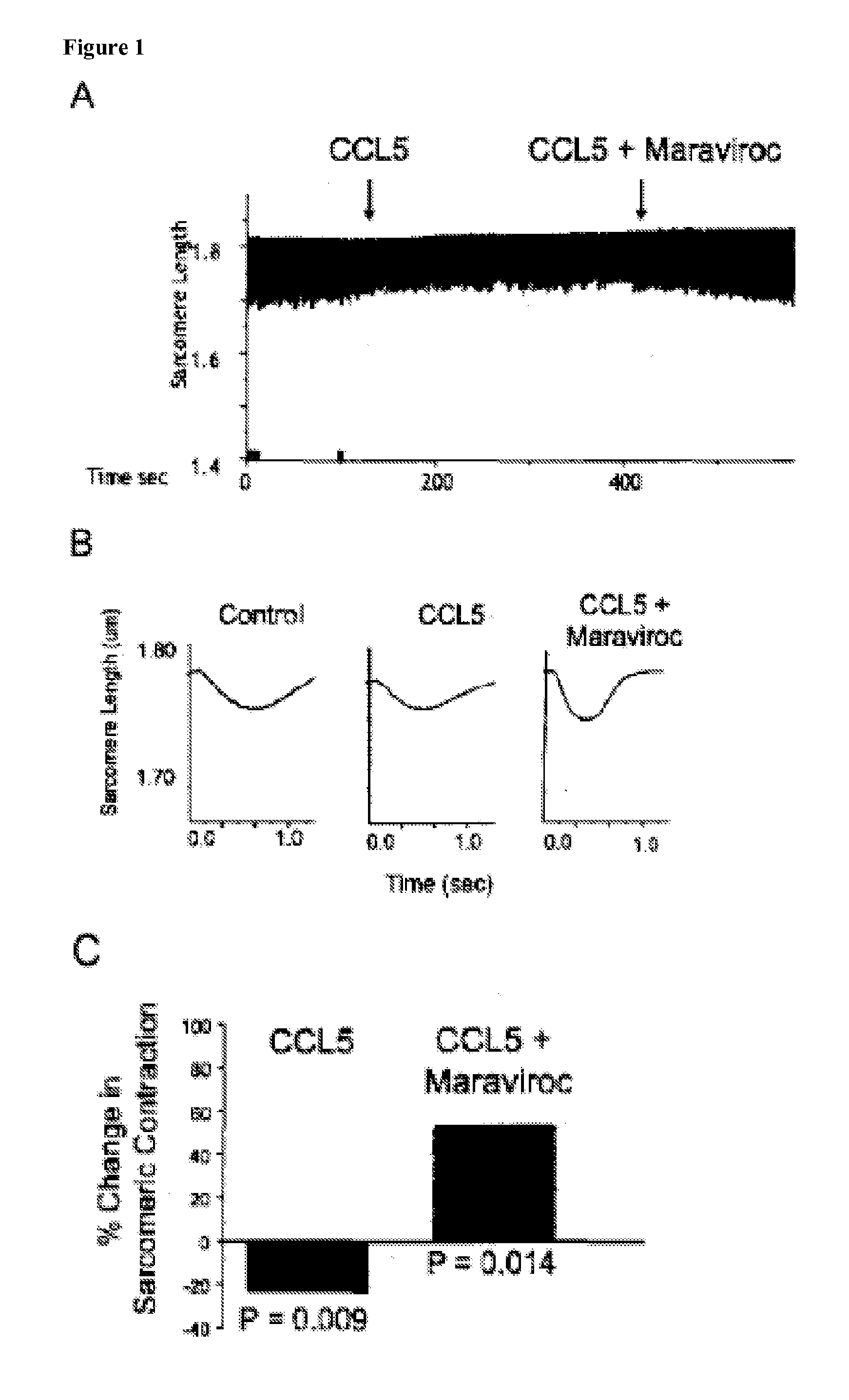Methods for Treating or Preventing Cardiac and Neurological Disorders Using Chemokine Receptor Antagonists
a technology of chemokine receptor and cardiac dysfunction, which is applied in the direction of immunoglobulins, peptides, drug compositions, etc., can solve the problems of limited knowledge of the molecular and cellular mediators of piv infection-related cardiac dysfunction and neurological disorders, and achieve cardiac dysfunction, prevent cardiac disorders, and reduce binding
- Summary
- Abstract
- Description
- Claims
- Application Information
AI Technical Summary
Benefits of technology
Problems solved by technology
Method used
Image
Examples
example 1
CCL5 Binding to CCR5 on Cardiomyocytes Impairs Cardiomyocyte Contractility
[0213]It has been observed that functional cardiac impairment develops in SIV-infected macaques. In addition to SIV, the chemokines CCL3, CCL4, and CCL5 can also bind to CCR5 and initiate signaling pathways. In order to evaluate the ability of CCL5 to alter sarcomeric contraction in a CCR5-dependent manner, isolated single cardiomyocytes were field stimulated (1 Hz) and sarcomeric contraction measured over time. Similar to SIV, addition of CCL5 led to decreased sarcomeric contraction in isolated macaque cardiomyocytes (FIG. 1A; n=4 single cardiomyocyte recordings). This reduction in contraction induced by SIV was reversed by addition of the CCR5 inhibitor, maraviroc. A representative single twitch trace of sarcomeric contraction (FIG. 1B) illustrates the decrease in sarcomere contraction induced by CCL5 (flattened curve) and then reversed by addition of maraviroc. The mean % decline in contraction induced by C...
example 2
CCR5 Inhibition Modulates Cardiac Viral Load, Preserves Diastolic Function, and Improves Cardiac Dysfunction
[0215]Twenty-two adult rhesus macaques (mean age=11 years) pre-screened for SIV, STLV-1, and simian type D retrovirus were inoculated intravenously with the macrophagetropic clone SIV / 17E-Fr and the immunosuppressive swarm SIV / DeltaB670 (FIG. 3). Age-matched adult rhesus macaques (mean age=11 years) were inoculated with media alone as controls. SIV-infected animals were euthanized when two or more AIDS-defining criteria were observed (mean length of infection=218 days postinoculation); control animals were euthanized at time-points exceeding the mean time post-inoculation for SIV-infected animals to control for potential confounding effects of ageing on cardiac performance (mean length=317 days post shaminoculation). At euthanasia, all animals were perfused with saline to remove blood from the systemic vasculature. Hearts were immediately harvested and samples were immersion f...
example 3
CCR5 Inhibition Modulates Neural Viral Load and Provides neuroprotective effects
[0220]To determine whether the CCR5 antagonist maraviroc altered CNS disease progression, SIV-infected animals from were treated with maraviroc and CNS outcomes were compared with untreated SIV-infected animals. Specifically, six rhesus macaques were inoculated with SIV / 17E-Fr and SIV / DeltaB670 and treated with maraviroc (200 mg PO BID) beginning 24 days post-inoculation until the study endpoint 180 days postinoculation, 22 SIV-infected animals served as untreated, SIV-infected controls, and 8 additional animals served as untreated, uninfected controls (Example 2). Maraviroc levels in plasma and CSF were measured using liquid chromatography tandem mass spectrometry. SIV RNA levels in plasma, CSF, spleen, and brain were measured by qRT-PCR. Immunostaining for CD68 and amyloid precursor protein (APP) in the brain was measured by digital image analysis. Group comparisons were performed by the Mann-Whitney t...
PUM
| Property | Measurement | Unit |
|---|---|---|
| sweep speed | aaaaa | aaaaa |
| volume | aaaaa | aaaaa |
| annular velocity | aaaaa | aaaaa |
Abstract
Description
Claims
Application Information
 Login to View More
Login to View More - R&D
- Intellectual Property
- Life Sciences
- Materials
- Tech Scout
- Unparalleled Data Quality
- Higher Quality Content
- 60% Fewer Hallucinations
Browse by: Latest US Patents, China's latest patents, Technical Efficacy Thesaurus, Application Domain, Technology Topic, Popular Technical Reports.
© 2025 PatSnap. All rights reserved.Legal|Privacy policy|Modern Slavery Act Transparency Statement|Sitemap|About US| Contact US: help@patsnap.com



